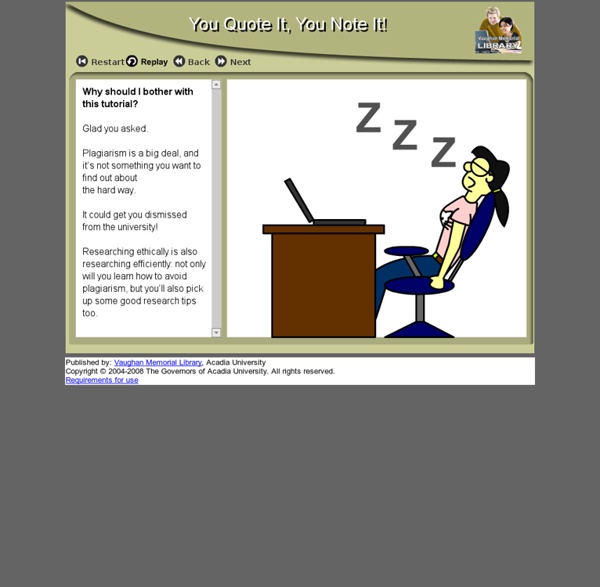



Digital Credibility: 13 Lessons For the Google Generation - 13 Digital Research Tools And The Credibility Lessons They Teach by TeachThought Staff This post is promoted by Noet, makers of Encyclopedia Britannica Noet Edition and the free research app for the classics, who asked us to talk about the credibility of information research in a digital world. We thought, then, that it might make sense to focus on digital tools and resources that highlight the idea of credibility. And because credibility and research are such important digital concepts–or really, data and thinking concepts, actually–we itemized each tool as lesson in and of itself. The Google Generation has a universe of information, right there on a little pinch-and-zoom screen. Further, “by ignoring the phases of inquiry learning, premature Googlers often find what they want rather than what they might need. This doesn’t make digital research better or worse, but rather different. Lesson 1: Not all sources are created equal. Lesson 2: Access matters–so improve it.
Blog Archive » Let Word 2007 Cite your Sources for You Nothing ruins the good time of writing a final paper faster than citing your sources. And which style do you have to use? There’s MLA, APA, Chicago, and some nonsense called Turabian which, frankly, sounds made-up. In olden times, you had to drop what you were doing to dig your style guide out of a cardboard box somewhere to figure out the correct format. Once you’ve entered your source information and selected which format you need, Word 2007 will create your in-text citations for you, then put ‘em all together for the grand finale, a flawless bibliography. Your your Word-enabled students will appreciate this time-saving trick. The Microsoft Office Word Team’s Blog via Lifehacker Related Stuff: Create Ottomated Bibliographies with OttoBibReveal Your Sources: Son of Citation Machine
Episode 145: 5 Essential Digital Notetaking Methods @coolcatteacher Whether it is digital notetaking or notetaking, many of us agree that most students are not effectively using this technique to remember, retain, and process new information. Dr. Tom Grissom is a pioneer in the effective use of digital notes, pushing us to redefine what notes can be. Listen to Show #145 Subscribe on iTunes Tom’s big point about notetaking is that if we follow the SAMR model, we must redefine what notetaking can be. WritingRecording AudioCollaboratively Writing with OthersSnipping Copies of the ScreenRecording VideoRecording Movements on the Screen (Screencasting)Students Can Share and See Each Other’s NotesTeachers Can Share Their NotesTeachers Can See Notes as a Formative Assessment Tool Tom and I also have a discussion about the vital difference between taking notes by hand and typing the notes (which leads to transcription.) Using One Note Classroom, Tom is a pioneer in the use of digital notes to teach, learn, and enrich our lives.
Sweet Search Blog Archive » Top 5 citation applications Back in my day we had to figure out arcane citation formats by poring through dusty old style manuals. This was during that awkward window after people started putting good information on the internet, but before the style manuals told you how to cite web documents. Your students don’t know how lucky they are to have handy pieces of software to do this arduous work for them. Below is Instructify’s list of the five best bibliography and citation applications out there. Pass these on to your students and spare them the agony of building bibliographies the hard way. 5. 4. 3. 2. 1. Are you an ardent user of one of these? Photo credit: papertrix on Flickr.
Understand what you read Kate Chopin: The Awakening, The Storm, stories, biography Harvard System of Referencing Guide Any in-text reference should include the authorship and the year of the work. Depending on the nature of the sentence/paragraph that is being written, references to sources may be cited in the text as described below: Additional support on how to introduce such references is available from Student Support in their guide. When making reference to an author's whole work in your text, it is sufficient to give the name followed by the year of publication of their work: When writing for a professional publication, it is good practice to make reference to other relevant published work. However, where you are mentioning a particular part of the work, and making direct or indirect reference to this, a page reference should be included: Cormack (1994, pp.32-33) states that "when writing for a professional readership, writers invariably make reference to already published works". For more examples, see page numbers section. Smith (1946) and Jones (1948) have both shown ... Directly using an and or
Kate Chopin: A Re-Awakening [ About the Program | Interviews | Chronology ] [ Electronic Library | Additional Resources | Credits ] Referencing@Portsmouth Kate Chopin, 1851-1904 Chopin, Kate 1851-1904, Writer. Although Katherine O'Flaherty Chopin was a native of St. Louis (born 8 February 1851) and spent barely 14 years in Louisiana, her fiction is identified with the South. At 19, Kate O'Flaherty married Oscar Chopin, a young cotton broker, and moved with him to New Orleans and later to his family home in Cloutierville, La., near the Red River. After Oscar died in 1882, she returned with their six children to St. Distinctly unsentimental in her approach, she often relied on popular period motifs, such as the conflict of the Yankee businessman and the Creole, a theme that informs her first novel, At Fault (1890), and several of her short stories. Chopin died of a brain hemorrhage after a strenuous day at the St. [Note: Recent scholarship points to a birth year of 1850 for Kate Chopin. Barbara C. Barbara C.
Study Skills - How to Study